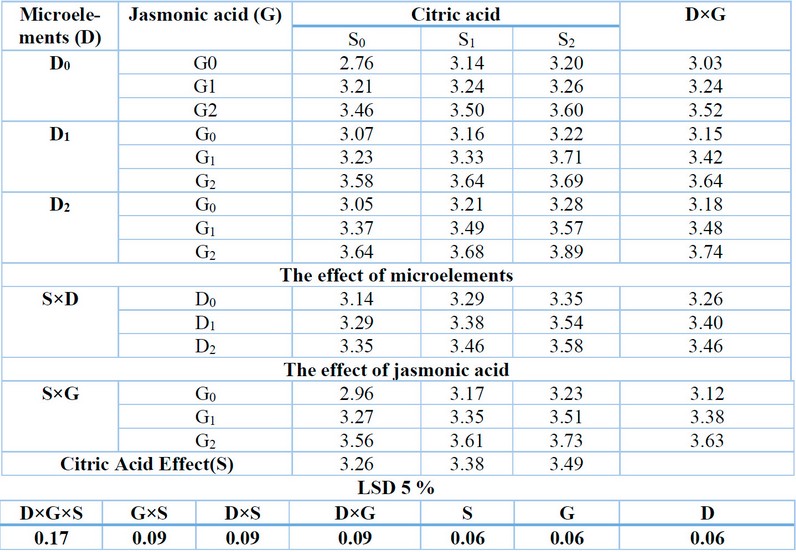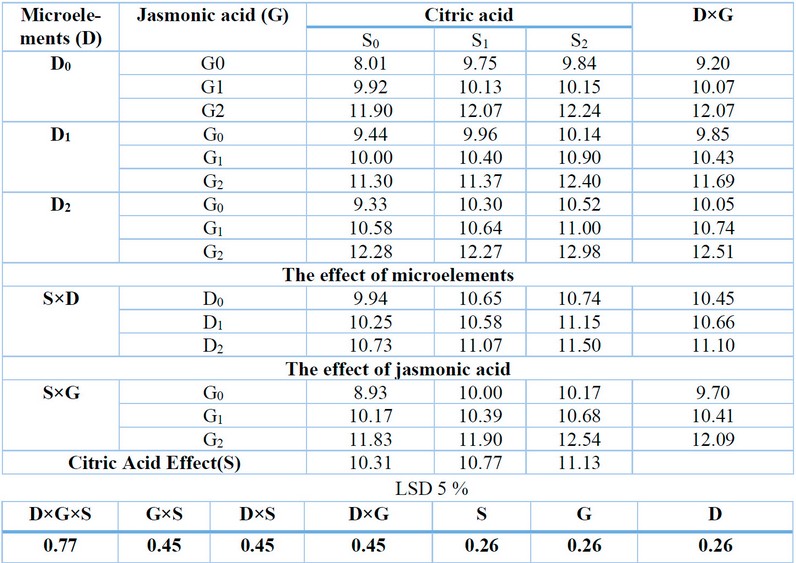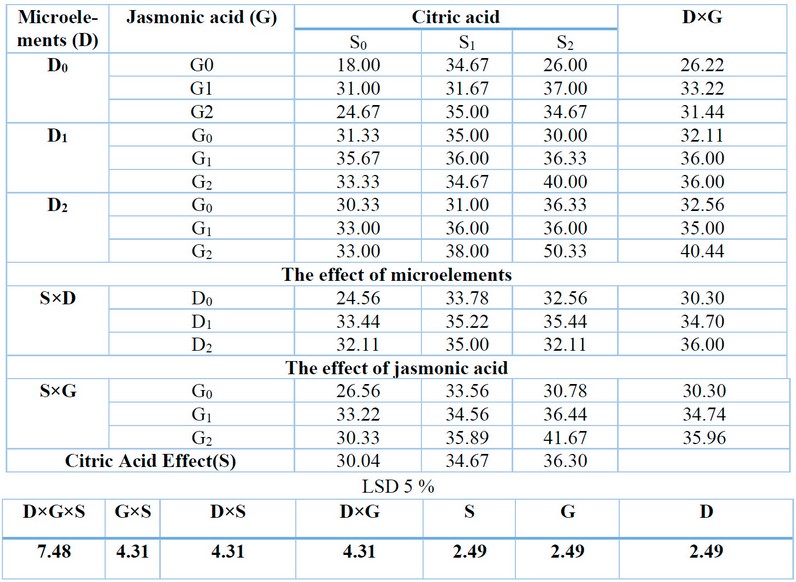Vol 9 No 1 2024-53
2024..09.01.53
Effect of injection with microelements, jasmonic and citric acid on some date palm c.v Khastawi yield traits
W. Taha1, Kh.A.S. Al-Hamdani2 and KH. N. AL-Assal2*
1Tikrit University, College of Agriculture; ammarwaleedtaha@gmail.com.
2Samarra University, College of Agriculture; khaild_sa@tu.edu.iq.
* Correspondence: ammarwaleedtaha@gmail.com.
Available from. http://dx.doi.org/10.21931/RB/2024.09.01.53
ABSTRACT
The study was conducted at the Ishaqi palm plant affiliated with the Department of Horticulture/Ministry of Agriculture during the growing season of 2021 on date palm trees of the Khastawi variety to study the response of the yield traits of the Khastawi date palm trees to the injection of microelements, jasmonic and citric acid. The study included three factors: The first factor is the injection of microelements with three treatments: injection with water only, symbolized by D0, iron injection at a concentration of 300 mg, and iron sulfate. Palm-1, symbolized by D1, and boron injection through boric acid at a concentration of 40 mg Palm-1, symbolized by D2. The second factor is the treatment of injections with the Jasmonic growth regulator, which was injected three days after the injection with the microelements and with the same number of additions (0, 50, 100) micrograms. L-1 is symbolized by G0, G1, and G2 sequentially. The trees were injected with the microelements and the Jasmonic growth regulator before Immunization, after vaccination in 20 days, and after 40 days. The third factor was injection with citric acid and included three levels (0, 500, 1000) mg l-1 symbolized by S0, S1, and S2 sequentially. The results showed that the D2 treatment was significantly superior in the average diameter, length, size and weight of the fruit and the total yield, as it reached 24.86 mm, 3.46 cm, 11.10 cm, 10.07 g, 36.00 kg.palm-1 sequentially, while the comparison treatment gave the lowest average for the traits. As for the effect of jasmonic acid, the injection treatment was superior to (100 µg L-1). (G2) gave the highest average for the diameter, length, size, weight of the fruit, and the total yield, which reached 25.90 mm, 3.63 cm, 12.09 cm, 10.93 g, and 35.96 kg. Palm-1, respectively, while the comparison treatment gave the lowest average for the traits above as for the effect of citric acid. The treatment exceeded 1000 mg.L-1 (S2) gave the highest rate in the diameter, length, size, and weight of the fruit, and the total yield, reaching 24.84 mm, 3.49 cm, 11.13 cm, 9.04 g, and 36.30 kg. Palm-1, respectively, while the comparison treatment gave the lowest average for the traits above, as the two- and three-interactions showed. The research factors have significant differences for all the studied traits.
Keywords: Trace elements, jasmonic acid, citric acid, Khastawi variety.
INTRODUCTION
The date palm (Phoenix dactylifera L.) belongs to the order Palmae and the family Palmaceae. This includes different types of palms, the most important of which is the date palm, which is widely cultivated in tropical, semi-tropical and subtropical regions, and some of them can live in temperate areas. Iraq is one of the oldest palm plantations in the world, with more than 600 varieties grown in it; God Almighty has singled him out with many virtues, as they are a source of goodness and blessings and was mentioned in 22 verses in the Holy Qur’an 1. The number of date palm trees in Iraq is 16,492,121 palm trees, while the total production is 676,111 tons, with an average production per palm of 68 kg Tree-1, 2.
The method of injecting elements into tree trunks is directly and immediately available to the tree, especially one that lacks these elements. Therefore, it works to reduce the symptoms of deficiency of these elements and improve the growth of the tree through its reflection on the health status of the leaves within days of conducting the treatment 3.
This technique of fertilization is of little use. However, it is more practiced in controlling pests and diseases, and it is recommended when fertilization methods on the soil or the leaves do not yield sufficient results. Therefore, its use on olive trees is limited to treating the deficiency of some nutrients, and the injection of the tree trunk prevents contamination of Air and water as the substance remains inside the tree and thus contributes to the effectiveness of the treatment 4. Stipes (1999) showed that the tree injection method includes two parts. The first is called microinjection, and the injection process is carried out under pressure and with a high concentration of fertilizers inside the hole in the tree. The second method is called normal macro injection. It is either by pressure or diffusion (without pressure), and a diluted solution is used in larger quantities than the first method and is achieved by making a hole in the stem or base of the tree. 5 stated that the fertilizer injected into the tree moves through the outer ring of the wood, where the majority of the water run-off is, and that 90% of the water run-off is located in the outer ring of the wood.
6 found significant differences in injecting Musa trees and Grand Naine with different concentrations of organic fertilizers. The two concentrations gave 75% and 100% on the highest results in each of the areas of one leaf, the total area of the leaves, number of leaves, specific weight, plant height and stem diameter,
7 that inject some nutrients into the trunks of Valencia orange trees at a concentration of 2.5 ml. L-1 led to significant differences, as the treatment Ca=0.7% was significantly superior to the total yield, acidity and K concentration, While the treatment N=0.8% was significantly superior to the percentage of juice and the concentration of Ca, Mg, Cu. 8 found that the Khastawi date palm cultivar was superior to the cucumber in the percentage of carbohydrates and total sugars when the stem was injected with Nutreeno nutrient solution at a concentration of 40 mlL-1. 9 when treating Al-Sayer date palm trees with citric acid at a concentration of 200 gm Palm-1, The treatment led to a significant increase in the length of the fruit and the content of the fruits from soluble solids and quantitative sugars, a decrease in the percentage of sucrose in the fruit, and an increase in the ratio of potassium to sodium in the leaves. And an increase in the weight of the weight and the quantitative yield of a tree.
Ten explained that when spraying date palm offshoots of Al-Barhi and Al-Sayer cultivars with citric acid to reduce soil salinity at a concentration of 500 and 1000 mg L-1, the concentration gave 500 mgL-1 significant increase in the leaves content of chlorophyll, potassium element and plant hormone IAA, While the spraying treatment with citric acid at a concentration of 1000 mgL-1recorded a significant increase in the leaf area and number of leaves, and the same treatment also recorded a substantial increase in the leaves content of the amino acid proline and carbohydrates.
11 showed that injecting FeSO4 solution into the trunks of date palm trees at a concentration of 2.5 g L-1 gave the highest fruit yield, weight and size.
Plant growth regulators are influential in stimulating the physiological processes necessary for plant growth and development, including jasmonic acid. This stress hormone consists of linolenic fatty acid and is crucial in stress resistance.
MATERIALS AND METHODS
The study was conducted at the Ishaqi date palm plant belonging to the Horticultural Department/Ministry of Agriculture during the 2021 growing season on date palm trees, Khastawi variety, aged 10 Years. The trees were chosen as homogeneous as possible in their vegetative growth and planted in the quadruple method 5 * 5 m. Soil samples were taken from the orchard before the treatments were conducted at a depth of 60 cm to conduct physical and chemical tests (Table 1).

Table 1: Some physical and chemical properties of the study soil.
RESULTS
Average diameter, length and size of the fruit
The results of Tables (2, 3 and 4) showed significant differences in the diameter, length and size of the fruit as a result of the trees being injected with microelements, as treatment D2 gave the highest average for the diameter, length and size of the fruit, as it reached 24.86 mm, 3.46 cm and 11.10 cm 3 in sequence. D1 followed it by giving it an average Measured at 24.45 mm, 3.40 cm, and 10.66 cm3, respectively, While the comparison treatment D0 gave the lowest average, as it reached 23.90 mm, 3.26 cm, and 10.46 cm 3, respectively.
The results of the same tables indicate that there are significant differences as a result of the injection with jasmonic acid, as treatment G2 gave the highest rate for the diameter, length and size of the fruit, as it reached 25.90 mm, 3.63 cm, 12.09 cm3sequentially, followed by treatment G1 by giving it an average of 24.29 mm, 3.38 cm, 10.41 cm3 sequentially, While the comparison treatment G0 gave the lowest average for the diameter, length and size of the fruit, as it reached 23.02 mm, 3.12 cm, 9.70 cm 3 sequentially. It was found that the injection with citric acid achieved a significant increase in the diameter, length and size of the fruit, as the treatment S2 gave the highest rate of 24.84 mm, 3.49 cm, 11.13 cm3 sequentially, Then followed by treatment S1 at a rate of 24.54 mm, 3.38 cm and 10.77 cm3 respectively, while treatment S0 gave the lowest average of 23.83 mm, 3.26 cm and 10.31 cm 3 respectively.
The bilateral interaction between boron and jasmonic had a significant effect, as the results of Tables (2, 3 and 4) showed significant differences, as the D2G2 treatment gave the highest average fruit diameter, length and size of 25.3 mm, 3.74 cm, 12.51 cm3, respectively, Whereas, treatment D0S0 gave the lowest average fruit size diameter and length, which were 22.45 mm, 3.14 cm, and 9.20 cm3 sequentially.
The results of the same tables showed a significant effect on the average diameter, length, and size of the fruit due to the interaction of boron and citric. The D2S2 treatment gave the highest rate of 25.31 mm, 3.58 cm, and 12.51 cm3 sequentially. Meanwhile, treatment D0S0 sequentially gave the lowest average fruit diameter, 23.26 mm, 3.14 cm, and 9.94 cm3.
The results of the tables also showed a significant increase when jasmonic and citric acid were overlapped, as treatment G2S2 was unique in giving it the highest rate of diameter, length and size of the fruit as it reached 26.14 mm, 3.73 cm, 12.54 cm3 sequentially, while treatment G0S0 gave the lowest rate of diameter, length and size of the fruit amounting to 21.99 mm. 2.96 cm and 8.93 cm3sequentially.
As for the tripartite interaction of the search treatments, the results of Tables (2, 3 and 4) indicate significant differences, as the treatment D2G2S2 gave the highest average for the diameter, length and size of the fruit amounted to 26.41 mm, 3.89 cm, 12.98 cm3, compared to the comparison treatment D0G0S0, which gave the lowest rate of 21.10 mm, 2.76 cm, 8.01 cm3 sequentially.

Table 2: Effect of microelements, jasmonic growth regulator and citric acid and their interaction on the average fruit diameter (mm).

Table 3: Effect of microelements, jasmonic growth regulator and citric acid and their interaction on the average fruit length (cm).

Table 4: Effect of microelements, jasmonic growth regulator and citric acid, and their interaction on the average fruit size (cm).
Fruit Weight (gm)
The results of Table (5) showed significant differences in the weight characteristic of the fruit as a result of the trees being injected with microelements. The effect increased when treatment D2 gave the highest average fruit weight of 10.07 g, followed by treatment D1, giving it an average of 9.81 g, while the comparison treatment D0 gave the lowest average weight. The fruit reached 9.14 g.
The results of the same Table also indicate significant differences as a result of jasmonic acid injection, as treatment G2 gave the highest fruit weight rate of 10.93 g, followed by treatment G1, giving it an average of 9.36 g. The comparison treatment G0 gave the lowest fruit weight rate of 8.73 g.
It was also found that the injection of citric acid achieved a significant increase in the average fruit weight, as treatment S2 gave the highest percentage of 9.04 g, followed by treatment S1 with a percentage of 9.82 g, while treatment S0 gave the least significant difference of 10.16 g. As for the effect of the injection, we note from the results of the same Table that the characteristic weight of the fruit is significantly affected by the injection of jasmonic acid and boron.
The interaction between boron and jasmonic had a significant effect, as the results of Table (5) showed significant differences, as the treatment D2G2 gave the highest average fruit weight of 28.67 g, whereas treatment D0G0 gave the lowest average fruit weight, which was 7.89 g. The same Table showed the significant effect on the average fruit weight due to the interaction of boron and citric. The D2S2 treatment gave the highest rate of 27.67 g, while the D0S0 treatment gave the lowest fruit weight rate of 11.78 g. The results of the same Table also showed a significant increase when jasmonic and citric acid were overlapped, as treatment G2S2was unique in giving it the highest average fruit weight, which amounted to 11.68 g. In comparison, treatment G0S0 gave the lowest average fruit weight of 7.94 g. As for the tripartite interaction of the search treatments, the results of Table (5) indicate significant differences, as treatment D2G2S2 gave the highest average fruit weight of 30.00 g, compared to the comparison treatment D0G0S0, which gave the lowest fruit weight rate of 7.00 g.

Table 5: Effect of microelements, jasmonic growth regulator and citric acid, and their interaction on the average fruit weight (gm).
Total yield (kg palm-1)
The results of Table (6) indicated that the percentage of the total yield was significantly affected due to the injection with microelements, as treatment D2 gave the highest content of 36.00 kg palm-1, followed by treatment D1 with a significant difference of 34.70 kg. palm-1, while it gave Treatment D0, which is the lowest yield of 30.30 kg. palm-1. It was also found from the results of the same Table that there were significant differences in the total yield rate as a result of the injection of jasmonic acid, as treatment G2 gave the highest rate of 35.96 kg. palm-1, followed by treatment G1 at a rate of 34.74 kg palm-1, Whereas, treatment G0 gave the least significant difference, which was 30.30 kgpalm-1.
It was also found that the injection of citric acid achieved a significant increase in the total yield rate, as treatment S2 gave the highest rate of 36.30 kg palm-1. Then, treatment S1 followed with a rate of 34.67 kg. palm-1, while treatment S0 gave the lowest rate of 30.04 kg. palm-1. The binary interaction between boron and jasmonic acid positively affected the overall yield; the D2G2treatment showed the highest rate of 40.44 kg palm-1, compared to the control treatment, which showed the lowest rate of 26.22 kg palm-1.
The results of Table (6) showed that the interaction of boron acid with citric acid caused a significant increase in the rate of the total yield, as the treatment D1S2 gave the highest rate of 35.44 kg palm-1, While the comparison treatment D0S0 gave the lowest rate of 24.56 kg palm-1. We also note from the results of Table (6) that the dual interaction of jasmonic acid with citric acid made a significant difference, as the treatment G2S2 gave the highest total yield of 41.67 kg. palm-1, Whereas treatment G0S0 gave the least significant difference for the total yield, 26.56 kg palm-1. As for the tripartite interaction of the search treatments, the results of Table (6) found significant differences, as the treatment D2G2S2 gave a higher total yield of 50.33 kgpalm-1, compared to the comparison treatment D0G0S0, which gave the lowest yield rate of 18.00 kgpalm-1.

Table 6: Effect of injections with microelements, jasmonic growth regulator and citric acid, and their interaction on the total yield (kg).
DISCUSSION
The moral superiority in yield characteristics (diameter, size, weight of the fruit, total yield) of palm fruits shown in tables (2, 3, 4, 5) is only a result of the role played by the chemical fertilizer consisting of zinc and boron in maintaining plant growth and activity through its effect On the physiological functions of trees, especially the photosynthesis process, which stimulates the plant to absorb water , And the nutrients that the plant needs in performing its vital processes and giving direct signals to build specific hormones to perform certain functions of the plant, such as the hormone fluorogen, which is specific to flowers, which accelerates the maturation of tissues and internal cells and thus pushes trees to form flowers and build different compounds and proteins and activate the cofactors of enzymes and hormones in building cell walls and transporting Sugars, absorption of major and minor minerals, gathering of various amino acids within plant tissues, and an increase in the rate of fruit setting, thus increasing the yield of trees 12, 13. The positive superiority in the weight, size, diameter and length of the fruit was due to the elements zinc and boron in creating a state of balance in regulating vital processes and increasing the absorption of mineral elements such as nitrogen, phosphorous, potassium, zinc and boron in the leaf, which in turn stimulated cell division and doubling, which led to an increase in the size of the fruit and the thickness of the pulp And its weight, it may also be due to the role of the two elements in increasing the ratio of carbohydrates to nitrogen C/N, which positively reflected on the accumulation of various components and nutrients in plant tissues 14, 15. At the same time, the moral superiority in yield traits may be due to the effect of citric acid, which increases the ability of the plant to carry out the process of photosynthesis, which helps the plant absorb food. It also has a role in improving the qualities of fruits 16.
CONCLUSIONS
The injection of micro-elements (iron and boron) showed a positive response in all vegetative growth characteristics, as well as the percentage of knots and fruit yield in palm trees, especially when treated with D2 at a level of (40 mg. L-1) under the conditions of the current experiment.
Jasmonic acid has a significant role in giving the best growth of trees and increasing the formation of chemical compounds and mineral elements in the leaves, as well as the other studied characteristics. These results were achieved when the treatment G2 level (100 μg.l-1).
The injection of citric acid led to a significant increase in the vegetative growth and production of trees, as the treatment (S2) outperformed (1000 mg.L-1).
There is an apparent significant effect on the leaf content of citric jasmonic acid with increased jasmonic acid injections, as shown by GC-MS Chromatography Mass Spectrometry (Gas).
Injection of micro-elements, citric acid, and jasmonic acid together led to an apparent increase in all studied traits, such as vegetative and fruit growth, average of (the diameter, length, size, weight of the fruit, and the total yield).
REFERENCES
1. Al-Hamdani, Kh. A. S., M. M. Hassan, M. N.Hussein. 2022. Date palm. Tikrit University Press. Ministry of Higher Education and Scientific Research, Iraq.
2. Central Statistical Organization. 2017. Annual Statistical Group – Ministry of Planning – Department of Publication and Public Relations – Baghdad – Iraq.
3. Hill Road. 2011. Iron chlorosis. www.arborjet.com .
4. Darwish, Monem Abed. The olive tree, techniques of cultivation and processing of its fruits. Baghdad, Iraq, Ministry of Agriculture – Department of Horticulture – Project for developing and disseminating cultivation in Iraq. 2015. Joy Press.
5. Harrell, M . Tree injections and implants. 2011. Tactics and Tools for IPM, Chapter 5, pp 3234.
6. Felipe, G. R.; U.V. Andres; C.S. Gerardo; S. Magnitskiy, and J. S. Henao . Effect of fertilizer insertion in the harvested mother banana plant pseudostem (Musa AAA Simmonds). Agronomía Colombiana. 2013. 31(1), 103-111.
7. Paula, A. L. ; M. Maria and Y. Elvira . Effects of nutritional trunk injections on Valencia late orange production. Cultivon Tropicales , . 2015 vol.36 , no.2 , pp. 142 – 147 .
8. Al-Dulaimi, R. M. H. and I. N. S. Al-Jumaili. Effect of injecting Nutreeno Nutrient solution on Khastawi and Cucumber date palm cultivars yield traits.Anbar Journal of Agricultural Sciences. 2015. Volume 13, Issue 1.
9. Toaimo, Mohamed Hadi. Effect of sulfur, calcium and ,citric acid in improving salt tolerance, specific fruit characteristics and ,productivity of date palm (L dactylifera Phoenix Al-Sayer). Master Thesis – Agricultural College – University of Basra – Iraq . 2015. – 97 p.
10. Shareef, H.J. Role of antioxidants in stress tolerant of date Palm offshoots ( Phoenix dactylifera L. ) femal and male cultiver . International Journal of Current Agricultural Research. 2015. , 3 ( 12 ).
11. Jahanshah S. ; Y. Hosseini, and M. Ghoreishi . Is Trunk Injection More Efficient Than Other Iron Fertilization Methods in Date Palms Grown in Calcareous Soils. Journal of Advanced Agricultural Technologies. 2016 . Vol. 3, No. 3, September .
12. Makhoul. G , Mouhammad .N , Abu Alshamlat A. Z. R. Influence of Foliar Application of Boron , Zinc and Humic acid on Tree Growth and Flowering of Olive tree ( khodeiry variety ). Tishreen University Journal for Research and Scientific Studies – Biological Sciences Series .2020. Vol. (14) No. (5) 9142.
13. Genaidy, A. E., N. Abd-Alhamid, S. A. Hassan, A. M. Hassan and L.63 F. Hagagg Effect of foliar application of boron trioxide and zinc oxide nanoparticles on leaves chemical composition, yield and fruit quality of Olea europaea L. cv. Picual, Genaidy et al. Bulletin of the National Research Centre 2020. 44:106.
14. Jasrotia. A, P. Bokshi and V.K.Wall Influence of girdling and zinc and boron application on growth ,quality and leaf nutrient status of olive Cv.Frantoio.Afr.J .Agric. . 2014 .9 (8):1354-1361.
15. Haluk, B., Gurel, S The influence of Zn, Fe and B applications on leaf and fruit absorption of table olive «Gem-like» based on phonological stages. Scientia Horticulturae. 2016. 198. 336–343..
Received: October 9th 2023/ Accepted: January 15th 2024 / Published:15 February 2024
Citation: Taha, A..; Al-Hamdani, Kh.A.; AL-Assal, KH. Effect of injection with microelements, jasmonic and citric acid on some date palm c.v Khastawi yield traits. Revis Bionatura 2024; 9 (1) 53. http://dx.doi.org/10.21931/RB/2024.09.01.53
Additional information. Correspondence should be addressed to ammarwaleedtaha@gmail.com.
Peer review information. Bionatura thanks anonymous reviewer(s) for their contribution to the peer review of this work using https://reviewerlocator.webofscience.com/
All articles published by Bionatura Journal are made freely and permanently accessible online immediately upon publication, without subscription charges or registration barriers.
Bionatura ISSN. First 13909355 Ecuador. Scopus coverage years: from 2016 to the present
Publisher’s Note: Bionatura stays neutral concerning jurisdictional claims in published maps and institutional affiliations.
Copyright: © 2023 by the authors. They were submitted for possible open-access publication under the terms and conditions of the Creative Commons Attribution (CC BY) license (https://creativecommons.org/licenses/by/4.0/).



















